What's with all the Double Framerail talk?
What are they? Do I need one?
If you've been paying attention at the NSCA or OSCA races lately you might have noticed cars in the staging lanes that look a lot like Pro Mod wanna-bes. Yards of diagonals take up the mid sections of these cars, bracing everything from the four-link to the trans. What gives? Billy Glidden's car never looked like that, and it has been one of the fastest 10.5 cars for years - Do you kind of feel like everyone else gets the joke except you? Well, you're not alone. Guys like Leo Barnaby and late Steve Grebeck have pumped out some pretty stout hardware and won championships with their designs - Why?
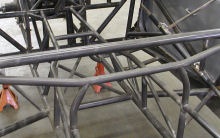 To answer this
question, let's look at some of the dynamics that take place when a big power,
automatic, well hooked (and that is an important distinction) car lets go of
the button and sends 1500+ hp rocketing down the driveline to a waiting ring
and pinion. Unlike a clutch car that may give up some 60' time to pick up 330'
utilizing wheel speed, the automatic car needs to (usually*) dead hook the tire
to take advantage of the torque converter's multiplication. The lower the first
gear is (numerically) the more critical the hook in that first 10' is- a 4.10
gear will multiply against the converter for a longer time than a 4.56 will. If
the 4.56 loses grip, odds are it will spin hard enough to slow acceleration,
then pull the motor down when the tire hooks- short time be damned. The 4.10
may recover earlier, before the engine senses the tire spin thru the converter.
(*I say usually because as auto cars get faster, they do benefit from wheel
speed like their clutch cousins. Most reading this won't have the power to spin
the tire, keep it spinning long enough to overcome the need for that stall
cushion -otherwise known as "getting up on the tire'- and transition to
converter lock-up gracefully. The powerglide car has to stay "up on the tire' a
looong time to avoid shake. A Powerlide's first gear is 1.80 or so and takes
longer to accelerate the driveline than a stick car that has a 2.52 or so first
and a .2 or so rear gear advantage. This takes a power to weight ratio
unattainable by most to turn that tire that long. For the purpose of this
article, we will deal with the majority that do not.)
To answer this
question, let's look at some of the dynamics that take place when a big power,
automatic, well hooked (and that is an important distinction) car lets go of
the button and sends 1500+ hp rocketing down the driveline to a waiting ring
and pinion. Unlike a clutch car that may give up some 60' time to pick up 330'
utilizing wheel speed, the automatic car needs to (usually*) dead hook the tire
to take advantage of the torque converter's multiplication. The lower the first
gear is (numerically) the more critical the hook in that first 10' is- a 4.10
gear will multiply against the converter for a longer time than a 4.56 will. If
the 4.56 loses grip, odds are it will spin hard enough to slow acceleration,
then pull the motor down when the tire hooks- short time be damned. The 4.10
may recover earlier, before the engine senses the tire spin thru the converter.
(*I say usually because as auto cars get faster, they do benefit from wheel
speed like their clutch cousins. Most reading this won't have the power to spin
the tire, keep it spinning long enough to overcome the need for that stall
cushion -otherwise known as "getting up on the tire'- and transition to
converter lock-up gracefully. The powerglide car has to stay "up on the tire' a
looong time to avoid shake. A Powerlide's first gear is 1.80 or so and takes
longer to accelerate the driveline than a stick car that has a 2.52 or so first
and a .2 or so rear gear advantage. This takes a power to weight ratio
unattainable by most to turn that tire that long. For the purpose of this
article, we will deal with the majority that do not.)
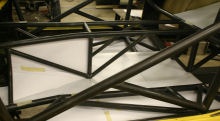 In other words, if you have a 1.80 first gear with a 6000-rpm converter you'd
better hook the tire or even limited wheel slip will kill your 60' and spoil
your pass. A car with a clutch will actually try to turn the tire a bit,
critical to keeping the engine from bogging and flipping the hood scoop in the
air. The clutch car also uses much looser gearing in the trans
and rear end. The differences your chassis sees are huge; all the pushing,
shoving and twisting your engine power transmits to your four-link is bound up
with nowhere to go when you dead hook a tire. The driveline is trying to catch
up to engine speed (converter stall speed at launch) with no "give' at the
tires to cushion the fury. Until the driveshaft catches up with the lock up
speed of the converter, the engine is not accelerating at an adequate rate to
keep the load off the chassis. It's as if it's being held by a dyno at launch
and again at the gear change. If you have enough power, and hook the tires well
enough, eventually the car will begin to flex and lose square. It won't respond
to a shock click or a flat of pre-load anymore. You can't make an accurate
tuning change because the car is unable to respond predictably at that power
level, and the more you continue to flex it the worse it's going to get.
In other words, if you have a 1.80 first gear with a 6000-rpm converter you'd
better hook the tire or even limited wheel slip will kill your 60' and spoil
your pass. A car with a clutch will actually try to turn the tire a bit,
critical to keeping the engine from bogging and flipping the hood scoop in the
air. The clutch car also uses much looser gearing in the trans
and rear end. The differences your chassis sees are huge; all the pushing,
shoving and twisting your engine power transmits to your four-link is bound up
with nowhere to go when you dead hook a tire. The driveline is trying to catch
up to engine speed (converter stall speed at launch) with no "give' at the
tires to cushion the fury. Until the driveshaft catches up with the lock up
speed of the converter, the engine is not accelerating at an adequate rate to
keep the load off the chassis. It's as if it's being held by a dyno at launch
and again at the gear change. If you have enough power, and hook the tires well
enough, eventually the car will begin to flex and lose square. It won't respond
to a shock click or a flat of pre-load anymore. You can't make an accurate
tuning change because the car is unable to respond predictably at that power
level, and the more you continue to flex it the worse it's going to get.
Does this mean that some Pro Mod or Pro Street cars are actually weaker than
the latest NPS cars? In some cases, the answer is yes. The tubing in John
Schroeder or Rob Golobo's late model cars is larger and thicker than
you'll find in many current Pro Mods. Consider this: the NPS car runs at a curb
weight 900 lbs heavier than a Pro Mod, it makes "only' 400-500 hp less (they
are in the neighborhood of 1700 hp) and must cut a 1.14 60' to be in the upper
half of the field. By comparison, our elite Pro cars may run as "slow' as a
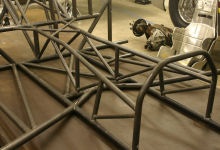 1.11 60' interval on the way to a 6.70 pass. The clutch car may have juggled
ratios and lock-up to get down a bumpy track, pouring the steam on late.
Neither of these are options most automatic teams have- they compete in single
stage nitrous classes and/or are locked into their gear ratios. They need to
hit it as hard as possible right away and keep it glued.
1.11 60' interval on the way to a 6.70 pass. The clutch car may have juggled
ratios and lock-up to get down a bumpy track, pouring the steam on late.
Neither of these are options most automatic teams have- they compete in single
stage nitrous classes and/or are locked into their gear ratios. They need to
hit it as hard as possible right away and keep it glued.
Now, it isn't all bad news for the automatic car. It has the advantage of a hydraulic coupling between the engine and the driveline, which softens the initial hit, disguises some tire spin, and it is very predictable to tune. Getting a car to hook up and cut low 60's is often easier with a converter than a clutch because of the smooth way it delivers power, and once you're happy with the stall, slip and multiplication, you're able to forget it and turn to other parts of the car. The clutch needs constant adjustment. This is all good news for the converter manufacturers, the motor, the tires, and the time-slip, but can be tough on your chassis.
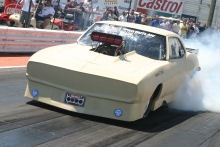 The answer has been to borrow a page from
the Pro Mod teams and install a double framerail, typically 1.250 x .058
hovering less than a foot above the main rails. Its job is to give a positive
link between the upper four link crossmember and the "mid hoop' or reinforcing
in the mid-plate area of the car. Some builders extend the rail forward, some
don't, it's a matter of preference, but they're all placed in a very deliberate
and careful manner so as to add strength and rigidity without adding
significant weight. A double framerail is not a diagonal; it is not run
rearward high to forward low, terminating at the base of the mid plate or foot
bar ala Jerry Bickel or Haas cars used in Pro Stock. (Great cars, just not an
example of what we're discussing.) It is a spine that protects the car from
tortional twist and flex, exactly the loads placed on a car by 632 inches,
nitrous, blowers, 1.80 first gear ratios, 4.10 final drives, and 35”
tires. A true double rail car is not a single rail car with an arbitrary
add-on; once in place, the upper rail sees a lot of force if installed
properly. Since cars designed to run a second framerail will often juggle
crossmember heights, widths of various spans, floor material, etc., it's
important to do an update with an open mind and understand what the original
intent of the car was as constructed. The update must work with the car's
strengths, but not enhance its shortcomings.
The answer has been to borrow a page from
the Pro Mod teams and install a double framerail, typically 1.250 x .058
hovering less than a foot above the main rails. Its job is to give a positive
link between the upper four link crossmember and the "mid hoop' or reinforcing
in the mid-plate area of the car. Some builders extend the rail forward, some
don't, it's a matter of preference, but they're all placed in a very deliberate
and careful manner so as to add strength and rigidity without adding
significant weight. A double framerail is not a diagonal; it is not run
rearward high to forward low, terminating at the base of the mid plate or foot
bar ala Jerry Bickel or Haas cars used in Pro Stock. (Great cars, just not an
example of what we're discussing.) It is a spine that protects the car from
tortional twist and flex, exactly the loads placed on a car by 632 inches,
nitrous, blowers, 1.80 first gear ratios, 4.10 final drives, and 35”
tires. A true double rail car is not a single rail car with an arbitrary
add-on; once in place, the upper rail sees a lot of force if installed
properly. Since cars designed to run a second framerail will often juggle
crossmember heights, widths of various spans, floor material, etc., it's
important to do an update with an open mind and understand what the original
intent of the car was as constructed. The update must work with the car's
strengths, but not enhance its shortcomings.
So when do you need a second frame rail? Chris Alston's catalog suggests the
7.99 mark is a good place to start; yet contemporary Pro Stock still doesn't
utilize the design. Evidently the short stroke, low torque nature of those
engines allows them to manage their torque without resorting to the weight of a
second rail. IHRA Pro Stock cars still 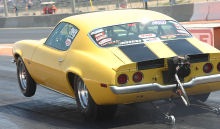 don't employ them with any regularity, but
their construction is getting burlier one by one, literally as they come out.
It won't be long before they're tough to tell from the Pro Mods. We suggest it
to our customers any time a car will see more than 1700 hp or so, especially
with a converter/beadlock combination. A 3500 lb 8.10 car with 33x16's will
need more support than a 2800 lb. car on 10.5's going the same times. Small
tires don't seem to load the chassis as much as a car with big tires at launch,
and weight is a big factor. We don't recommend the double rail option on a
10.5” car unless it will live most of its life in the 7's. Dan Millen's
10.5 Skinny Kid car is uncluttered compared to some of the jungle gyms out
there, but it is as fast and consistent as any in FFW or NSCA. Cars built to
SFI spec 25.2 have a more rigid floor, possibly reducing the load the upper
rail will see. That's what led us to keep Nick Scavo's second rail rather
minimal in his new car, when compared to the Stanley/Weiss Pro Outlaw 25.1E
piece finished mid '04.
don't employ them with any regularity, but
their construction is getting burlier one by one, literally as they come out.
It won't be long before they're tough to tell from the Pro Mods. We suggest it
to our customers any time a car will see more than 1700 hp or so, especially
with a converter/beadlock combination. A 3500 lb 8.10 car with 33x16's will
need more support than a 2800 lb. car on 10.5's going the same times. Small
tires don't seem to load the chassis as much as a car with big tires at launch,
and weight is a big factor. We don't recommend the double rail option on a
10.5” car unless it will live most of its life in the 7's. Dan Millen's
10.5 Skinny Kid car is uncluttered compared to some of the jungle gyms out
there, but it is as fast and consistent as any in FFW or NSCA. Cars built to
SFI spec 25.2 have a more rigid floor, possibly reducing the load the upper
rail will see. That's what led us to keep Nick Scavo's second rail rather
minimal in his new car, when compared to the Stanley/Weiss Pro Outlaw 25.1E
piece finished mid '04.
It boils down to this; the stiffer the car, the more responsive it is to input; be it from power, pre-load, shock clicks, spring rate or bad driving. Not everything needs two rails in it, but using the chassis as a "fifth spring' is a less efficient way to the finish line. Today's shocks are so much better than the ones we had just 5 years ago, springs hold their rate with much improved accuracy, wheelie bars are built and tuned with greater precision, all contributing to a better, more gradual launch. Recent trends in chassis construction like anti roll bars, thicker and stronger four link bars and fabricated housings have locked the movement of the suspension in place. Why would we let everything forward of that twist around wasting energy? It only takes a slight shift of the fourlink area to make the car react as if its preload had changed, mid run. By designing a car with a second framerail we can end up with a faster, stiffer, safer racecar.
